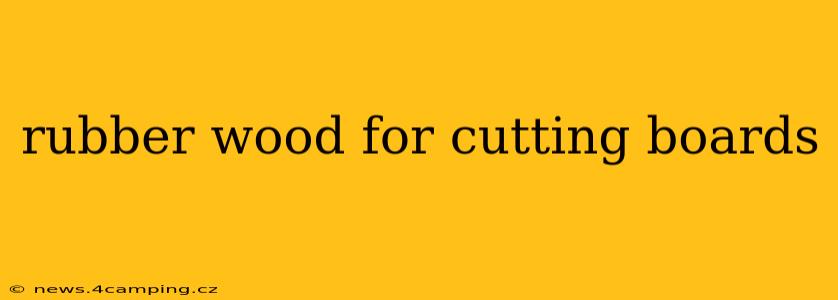Rubberwood, a sustainable hardwood increasingly popular for kitchenware, offers a compelling alternative to traditional cutting board materials. Its durability, affordability, and eco-friendly nature make it a strong contender. But is it the right choice for your kitchen? This comprehensive guide dives deep into the world of rubberwood cutting boards, addressing common questions and concerns.
Is Rubberwood Good for Cutting Boards?
Yes, rubberwood is a suitable material for cutting boards, offering several advantages. Its hardness and density provide good resistance to knife cuts, preventing excessive gouging and damage. Furthermore, its relatively tight grain structure minimizes the risk of bacteria harboring in crevices. However, it’s not indestructible and requires proper care to maintain its longevity.
What are the Pros and Cons of Rubberwood Cutting Boards?
Pros:
- Sustainable: Rubberwood is a byproduct of the rubber tree industry, making it an environmentally friendly choice. Trees are harvested after their latex production ceases, preventing deforestation and promoting sustainable forestry.
- Affordable: Compared to hardwoods like maple or bamboo, rubberwood is generally more budget-friendly.
- Durable: While not as hard as some other woods, rubberwood offers decent resistance to knife marks and wear.
- Aesthetically Pleasing: Rubberwood often has a light, warm tone that enhances kitchen aesthetics.
- Easy to Clean: With proper care, rubberwood cutting boards are relatively easy to clean and maintain.
Cons:
- Porosity: While less porous than some woods, rubberwood can still absorb liquids, potentially harboring bacteria if not properly cared for.
- Not as Hard as Some Woods: Compared to harder woods like maple or end-grain butcher blocks, rubberwood may show more knife marks over time.
- Susceptibility to Staining: Darker liquids and oils can stain rubberwood, affecting its appearance.
- Requires Regular Oil Treatment: To maintain its durability and prevent cracking, regular oiling is necessary.
How Do You Care for a Rubberwood Cutting Board?
Proper care is crucial for extending the lifespan of your rubberwood cutting board. Here’s how:
- Hand Wash Only: Avoid dishwashers, as the high heat and harsh detergents can damage the wood.
- Wash with Warm, Soapy Water: Gently wash with warm water and a mild dish soap after each use.
- Dry Thoroughly: Completely dry the cutting board with a clean towel after washing. Leaving it damp can promote mold and mildew growth.
- Regular Oil Treatment: Apply a food-safe mineral oil or cutting board conditioner every few weeks or as needed, depending on frequency of use. This helps to prevent drying and cracking.
- Avoid Soaking: Avoid soaking the cutting board for extended periods.
Is Rubberwood Cutting Board Safe?
When properly cared for, rubberwood cutting boards are safe for food preparation. However, it's crucial to follow proper cleaning and maintenance procedures to prevent bacterial growth and contamination. Choosing a board from a reputable supplier helps ensure the wood has been properly treated.
Are Rubberwood Cutting Boards Eco-Friendly?
Yes, rubberwood is widely considered an eco-friendly material. It's a byproduct of the rubber industry, meaning trees are harvested only after they are no longer productive for latex. This sustainable harvesting practice prevents deforestation and promotes responsible forestry.
How Long Do Rubberwood Cutting Boards Last?
With proper care and maintenance, a rubberwood cutting board can last for several years. However, the lifespan will depend on factors like frequency of use, cleaning practices, and how well it is oiled.
Can I Use Rubberwood Cutting Boards for Meat?
Yes, you can use rubberwood cutting boards for meat, but ensure you thoroughly clean and sanitize them after use to prevent cross-contamination.
This guide provides a thorough overview of rubberwood cutting boards, addressing many common concerns and providing essential maintenance tips. Remember, responsible usage and proper care will ensure your rubberwood cutting board remains a safe and functional part of your kitchen for years to come.
